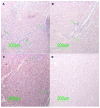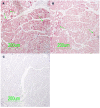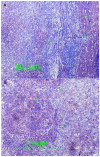Sudden unexpected death related to enterovirus myocarditis: histopathology, immunohistochemistry and molecular pathology diagnosis at post-mortem
- PMID: 22966951
- PMCID: PMC3462138
- DOI: 10.1186/1471-2334-12-212
Sudden unexpected death related to enterovirus myocarditis: histopathology, immunohistochemistry and molecular pathology diagnosis at post-mortem
Abstract
Background: Viral myocarditis is a major cause of sudden unexpected death in children and young adults. Until recently, coxsackievirus B3 (CVB3) has been the most commonly implicated virus in myocarditis. At present, no standard diagnosis is generally accepted due to the insensitivity of traditional diagnostic tests. This has prompted health professionals to seek new diagnostic approaches, which resulted in the emergence of new molecular pathological tests and a more detailed immunohistochemical and histopathological analysis. When supplemented with immunohistochemistry and molecular pathology, conventional histopathology may provide important clues regarding myocarditis underlying etiology.
Methods: This study is based on post-mortem samples from sudden unexpected death victims and controls who were investigated prospectively. Immunohistochemical investigations for the detection of the enteroviral capsid protein VP1 and the characterization and quantification of myocardial inflammatory reactions as well as molecular pathological methods for enteroviral genome detection were performed.
Results: Overall, 48 sudden unexpected death victims were enrolled. As for controls, 37 cases of unnatural traffic accident victims were studied. Enterovirus was detected in 6 sudden unexpected death cases (12.5 %). The control samples were completely enterovirus negative. Furthermore, the enteroviral capsid protein VP1 in the myocardium was detected in enterovirus-positive cases revealed by means of reverse transcriptase-polymerase chain reaction (RT-PCR). Unlike control samples, immunohistochemical investigations showed a significant presence of T and B lymphocytes in sudden unexpected death victims.
Conclusions: Our findings demonstrate clearly a higher prevalence of viral myocarditis in cases of sudden unexpected death compared to control subjects, suggesting that coxsackie B enterovirus may contribute to myocarditis pathogenesis significantly.
Figures




References
Publication types
MeSH terms
Grants and funding
LinkOut - more resources
Full Text Sources
Research Materials

